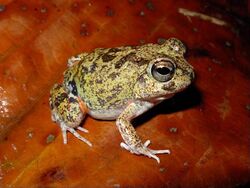Biology:Leiuperinae
| Leiuperinae | |
|---|---|

| |
| Pleurodema brachyops | |
| Scientific classification | |
| Domain: | Eukaryota |
| Kingdom: | Animalia |
| Phylum: | Chordata |
| Class: | Amphibia |
| Order: | Anura |
| Family: | Leptodactylidae |
| Subfamily: | Leiuperinae Bonaparte, 1850 |
| Type genus | |
| Leiuperus Duméril and Bibron, 1841
| |
| Synonyms | |
|
Leiuperina Bonaparte, 1850 | |
The Leiuperinae are a subfamily of frogs in the family Leptodactylidae. Over 90 species are in five genera. The distribution of this subfamily is from southern Mexico to the Central America and much of South America.[1]
Taxonomy
Recognition of the Leiuperinae as it is known today is relatively recent. Frost et al. (2006) treated the Leiuperina as a part of the Leptodactylidae,[2] whereas Grant et al. (2006) recognized them as a family,[3] the view adopted by some sources.[4][5] However, the Amphibian Species of the World follows Pyron and Wiens (2011)[6] in recognizing this taxon as a subfamily.[1] However, AmphibiaWeb includes leiuperinid genera in the Leptodactylidae, without recognizing them as a subfamily.[7]
Genera
The five genera are:[1]
- Edalorhina Jiménez de la Espada, 1870
- Engystomops Jiménez de la Espada, 1872
- Physalaemus Fitzinger, 1826
- Pleurodema Tschudi, 1838
- Pseudopaludicola Miranda-Ribeiro, 1926
Defensive Mechanisms
Leiuperinae display several anti-predator mechanisms, including eyespots, hidden bright colours, macroglands in a inguinal/lumbar position, defensive behaviours, and/or chemical defence.[8] A 2021 study showed the most recent ancestor of Edalorhina, Engystomops, Physalaemus, and Pleurodema evolved a particular type of serous gland (the main component of macroglands) in the lumbar skin along with the absence of the Eberth-Katschenko layer.[8][9] Leiuperines with macroglands exhibit a defensive behaviour which includes four displays ('crouching down', rear elevation, body inflation, and eye protection) all of which are present in this same common ancestor.[8] Several species independently evolved the two elements associated with aposematism (hidden bright colours and eyespots).[8][10] Overall, the study provided phylogenetic evidence for the startle-first hypothesis,[11] i.e. behavioural displays arise as sudden movements in camouflaged individuals to avoid predatory attacks, prior to the origin of bright coloration.[8]
References
- ↑ 1.0 1.1 1.2 Frost, Darrel R. (2015). "Leiuperinae Bonaparte, 1850". Amphibian Species of the World: an Online Reference. Version 6.0. American Museum of Natural History. http://research.amnh.org/vz/herpetology/amphibia/Amphibia/Anura/Leptodactylidae/Leiuperinae.
- ↑ Frost, D. R.; Grant, T.; Faivovich, J. N.; Bain, R. H.; Haas, A.; Haddad, C. L. F. B.; De Sá, R. O.; Channing, A. et al. (2006). "The Amphibian Tree of Life". Bulletin of the American Museum of Natural History 297: 1–291. doi:10.1206/0003-0090(2006)297[0001:TATOL2.0.CO;2].
- ↑ Grant, T.; Frost, D. R.; Caldwell, J. P.; Gagliardo, R.; Haddad, C. F. B.; Kok, P. J. R.; Means, D. B.; Noonan, B. P. et al. (2006). "Phylogenetic systematics of dart-poison frogs and their relatives (Amphibia: Athesphatanura: Dendrobatidae)". Bulletin of the American Museum of Natural History 299: 1–262. doi:10.1206/0003-0090(2006)299[1:PSODFA2.0.CO;2]. http://digitallibrary.amnh.org/dspace/bitstream/2246/5803/1/B299.pdf.
- ↑ Blackburn, D.C.; Wake, D.B. (2011). "Class Amphibia Gray, 1825. In: Zhang, Z.-Q. (Ed.) Animal biodiversity: An outline of higher-level classification and survey of taxonomic richness". Zootaxa 3148: 39–55. doi:10.11646/zootaxa.3148.1.8. http://mapress.com/zootaxa/2011/f/zt03148p055.pdf.
- ↑ "Leipueridae". Animal Diversity. http://animaldiversity.org/accounts/Leiuperidae/classification/#Leiuperidae.
- ↑ Pyron, A. R.; Wiens, J. J. (2011). "A large-scale phylogeny of Amphibia including over 2800 species, and a revised classification of extant frogs, salamanders, and caecilians". Molecular Phylogenetics and Evolution 61 (2): 543–583. doi:10.1016/j.ympev.2011.06.012. PMID 21723399.
- ↑ "Leptodactylidae". AmphibiaWeb: Information on amphibian biology and conservation. [web application]. Berkeley, California: AmphibiaWeb. 2015. http://www.amphibiaweb.org/lists/Leptodactylidae.shtml.
- ↑ 8.0 8.1 8.2 8.3 8.4 Ferraro, Daiana Paola; Pereyra, Martín Oscar; Topa, Pascual Emilio; Faivovich, Julián (2021). "Evolution of macroglands and defensive mechanisms in Leiuperinae (Anura: Leptodactylidae)". Zoological Journal of the Linnean Society 193 (2): 388–412. doi:10.1093/zoolinnean/zlaa149. https://academic.oup.com/zoolinnean/article/193/2/388/6042174.
- ↑ Taylor REJ; Taylor HC; Barker SB (1966). "Chemical and morphological studies on inorganic phosphate deposits". Journal of Experimental Zoology 161 (2): 271–285. doi:10.1002/jez.1401610210. PMID 5960620.
- ↑ Endler JA. (1991). "Interactions between predators and prey". Behavioural ecology and evolutionary approach. Oxford: Blackwell Scientific Publications. pp. 169–196.
- ↑ Umbers KDL; De Bona S; White TE; Lehtonen J; Mappes J; Endler JA (2017). "Deimatism: A neglected component of antipredator defence". Biology Letters 13 (4): 20160936. doi:10.1098/rsbl.2016.0936. PMID 28404819.
Wikidata ☰ Q13560507 entry
 |

